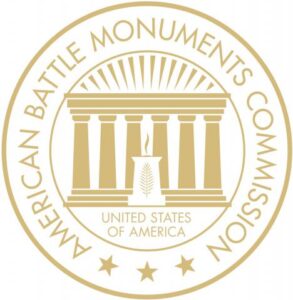Oise-Aisne American Cemetery is a World War I cemetery located in Seringes-et-Nesles, France. This American Battle Monuments Commission site contains the graves of more than 6,000 service members. Approximately 240 names are also commemorated on its Walls of the Missing. Most of the service members commemorated or memorialized there, lost their lives while fighting in the vicinity in 1918. But how well do you know this site?
A high number of women are buried at Oise-Aisne American Cemetery
Fifteen women are buried at the site. Seven of them were U.S. Army nurses and eight were part of the Young Men’s Christian Association or American Red Cross volunteers. Amongst them is a famous actress in those days, Mary Agnes Moore (1890–1919).
Moore came from a family of entertainers living in Beverly Hills where she and four of her brothers were actors. She began her brief film career in 1914 with silent movies like “The Brute” and “Lola.” The following year she took part in several silent movies “Prohibition,” “The Meddler,” and “The Great Divide.” In 1916 she was in “The Unconventional Girl” and in 1917, “Miss Deception.” Her acting career came to an end when she died of influenza at the age of 28 after she volunteered with the American Red Cross as a nurse in France in 1919. She died at the American convalescent hospital at Savenay, near St. Nazaire, and later was buried in Oise-Aisne American Cemetery in Plot A, Row 34, Grave 24.
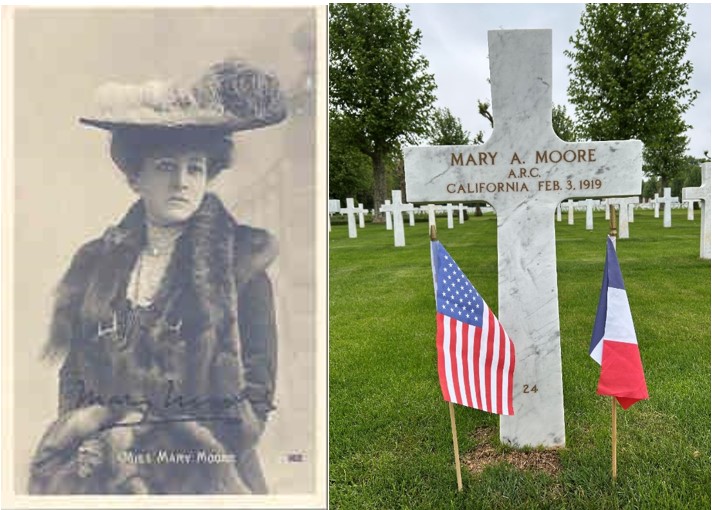
A connection to a famous book
The Knight brothers, who rest in Plots A and B, are among 12 sets of brothers at Oise-Aisne American Cemetery. They also have a connection to a third, famous brother. Five of the 12 sets of brothers at Oise-Aisne American Cemetery are buried side by side.
Edmund H. Knight and his brother Frederic H. Knight were killed in action crossing the River Ourcq on July 29 and 30, 1918, respectively. They were both sergeants in K Company, 110th Infantry Regiment, 28th Division while their brother, Eric Knight, served with the Princess Patricia’s Canadian Light Infantry. The three men were born and raised far from the countries they served, at the foot of the rolling green Dales of West Yorkshire in the North of England.
Their father was killed in the Boer War leaving his three boys, aged 5, 4 and 3, in the care of their mother. With no financial support, their mother became a governess for members of the Russian royal family in Harrogate, West Yorkshire, England.
However, in 1905 Mrs. Knight was faced with a decision which would change their lives forever. Her employers were moving abroad; she could keep her job and earn an increase in salary, but her sons would be left behind. If she remained in Yorkshire, they would face almost inevitable destitution. The boys were sent to live with uncles and aunts. Frederic and Edmund moved to East Ham in London while Eric travelled a few miles to the industrial city of Leeds. Mrs. Knight went with the Russian royal family to St. Petersburg and later to Philadelphia to escape the political and social unrest in Russia. She sent for her sons shortly after she arrived in Philadelphia. Eric found a school and a warehouse job. His brothers Edmund and Frederic had several other opportunities. They enlisted in the 110th Infantry Regiment, 28th Division.
When the U.S. entered the war, Frederic and Edmund were sent to France while Eric abandoned his studies and enlisted in the Canadian Army with a friend from Quebec. Eric was serving at Vimy Ridge when the war came to an end. He was summoned to see the adjutant and feared for the safety of his beloved uncles, all of whom had miraculously survived – but Frederic and Edmund had not.
Their graves in Oise-Aisne American Cemetery are several rows apart because at the time of their burial their relationship was not known. Their mother, came to visit them Aug. 27, 1930, when she sailed onboard the SS America during the Gold Star Mothers Pilgrimage. Edmund is buried in Plot A, Row 15, Grave 23, and Frederic is buried in Plot B, Row 12, Grave 31.
Eric went on to become a newspaperman, film critic, Hollywood script editor and author with nine novels and five best sellers to his name, but his early life and the adventures he had enjoyed with his brothers among the Yorkshire Dales would be reflected most poignantly in his best-known work – for Eric created one of the most enduring film and literary heroines of all time – Lassie.
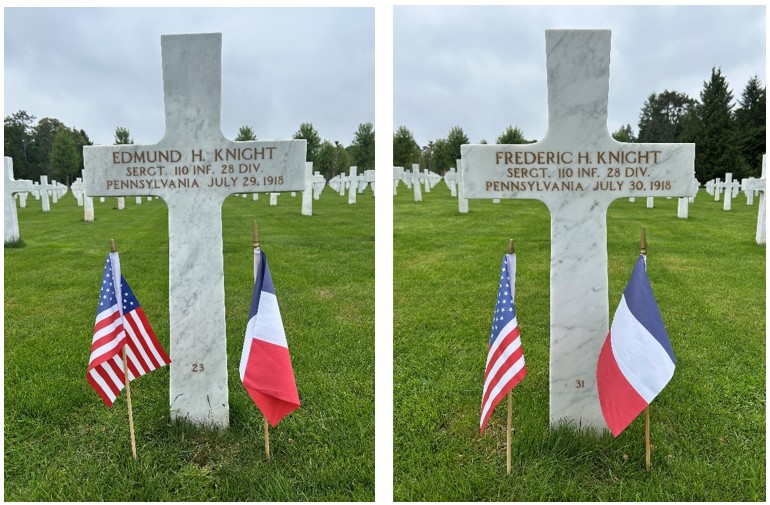
An unknown French soldier buried at Oise-Aisne American Cemetery
When the American Graves Registration Service was identifying casualties that had been brought to Oise-Aisne American Cemetery, it was discovered there had been a burial error.
When a grave was exhumed in 1921 for identification, the body buried was wearing a French uniform with the collar ornaments of the 156th French Infantry Regiment. A French prayer book, a rosary, and faded letters were found among the remains.
Based on the burial pattern, it is possible the French soldier was recovered from Le Charmel, Aisne, but this could not be confirmed. The remains may have been brought to Oise-Aisne American Cemetery by mistake, because they were initially incorrectly buried as an American soldier, but why the remains were never moved to a French cemetery, remains a mystery. This unknown French soldier is buried in Plot A, Row 30, Grave 36.
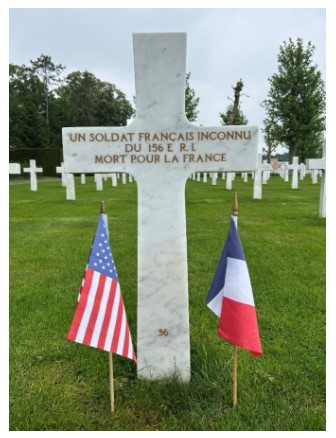
The son of a former American Battle Monuments Commission commissioner is buried on site
Eight American Field Service members are buried at Oise-Aisne American Cemetery, including Paul Cody Bentley, the son of ABMC’s first female commissioner Josephine L. Bentley. The American Field Service was born in World War I as a volunteer ambulance and medical corps supporting the Allied war effort before America entered the war.
Born Sept. 22, 1895, in Cleveland, Ohio. Bentley was the son of Frederick William and Josephine Cody Bentley. His home was in Chicago and he was educated in Chicago public schools, the University of Chicago and Harvard University, class of 1917. He attended Plattsburg Camps, a summer military training program for young men, in 1915 and 1916.
An eye issue spoiled Bentley’s chances of joining the U.S. Army so he joined the American Field Service and sailed to France May 19, 1917. He went to the front with Section 65 of the American Field Service, where according to a friend in his section, “Bentley was one of our best drivers. He never complained. He took dangers as they came without flinching. Everybody who came in contact with him admired him.”
Bentley was wounded in battle on Chemin des Dames in September 1917 and died in the hospital Sept. 16. He was awarded the French Croix de Guerre. He is buried at Oise-Aisne American Cemetery in Plot B, Row 12, Grave 21.
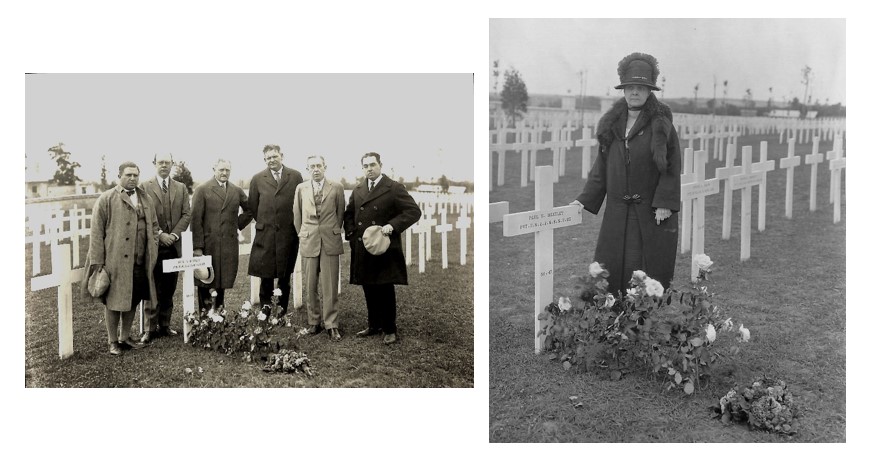
A famous poet buried at the site
Sgt. Joyce Kilmer was born in New Brunswick, New Jersey Dec. 6, 1886. He was educated at Columbia University, graduating in 1908.
From 1909 to 1912 he was associated with Funk and Wagnall’s Company, working as an editor on their dictionary. He served as literary editor of the “The Churchman,” an Anglican newspaper and in 1913 became a member of the staff of “The New York Times.” He wrote his famous poem “Trees” in 1913.
When the U.S. declared war on Germany in 1917, Kilmer was a family man with a wife and children. He would not have been required to serve. Nevertheless, he enlisted as a private in the 7th Regiment, New York National Guard. At his request and with the assistance of the unit’s chaplain, Father Francis P. Duffy, he transferred into the 165th Infantry Regiment, of the “Fighting 69th.”
While the Regiment was at Camp Mills, he was transferred to Headquarters Company and assumed the position of senior regimental statistician. Once in France, he quickly attained the rank of sergeant and was attached to the newly organized regimental intelligence staff as an observer. He spent many nights on patrol in no-man’s land gathering tactical information.
In his position on the regiment’s intelligence staff, Kilmer had no front-line responsibilities during combat operations, but he would not be kept out of action while his comrades were at risk. On July 30, 1918, during the Battle of the Ourcq, he attached himself as adjutant to Maj. William “Wild Bill” Donovan, commanding the 1st Battalion. Donovan’s adjutant, Lt. Oliver Ames had been killed in combat the day before. A sniper’s bullet ended the soldier-poet’s life. Kilmer died, at 31, facing the enemy. The regiment’s principal objective on that day was the high ground of Muercy Farm.
Kilmer was awarded the French Croix de Guerre for bravery. Camp Kilmer in New Jersey is named for him as are many other monuments and state parks in New Jersey and New York. He is buried at Oise-Aisne American Cemetery in Plot B, Row 9, Grave 15.
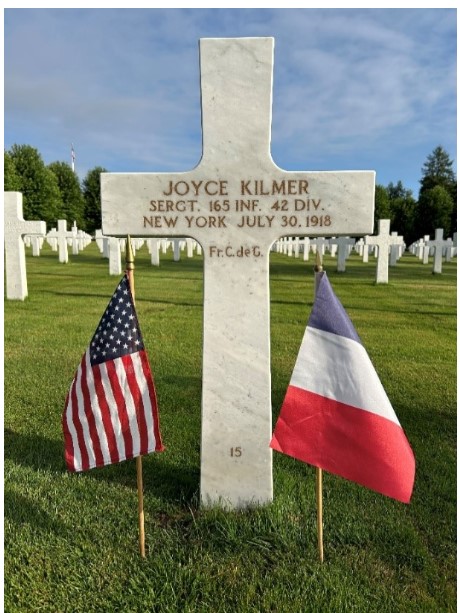
The American Battle Monuments Commission sites are a constant reminder of Gen. John J. Pershing’s promise that, “time will not dim the glory of their deeds.”
Sources:
Article created with the help of Oise-Aisne American Cemetery.
 An official website of the United States government. Here's how you know.
An official website of the United States government. Here's how you know. 